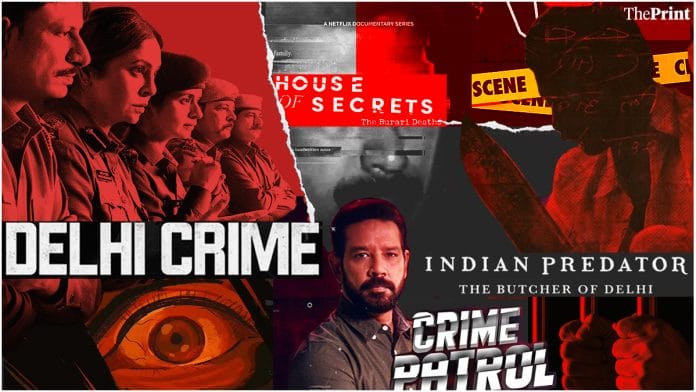Snapping every rickety door shut, I remember checking the nuts, bolts, and rafters in my south Delhi apartment before slipping under the sheets with my docile pet dog and blunt kitchen knife in close reach. One would think that this extreme reaction was due to an unwelcome intruder in my space, a ghost or perhaps a robber, but no. It was a rather enthusiastic response to the chilling second season of Delhi Crime on Netflix. Scarred as I was with their brutal bludgeoning of the elderly, I couldn’t evade the appeal that came with a partly real, partly fictional and very deadly ‘kachcha-baniyan’ gang lurking in familiar by-lanes. So, I continued to feed my curiosity from under the comfort and security of my blanket. And I am only one of the many Indians to do so.
Violence, gore, murder, mystery and drama—it is hard to pinpoint one reason behind the growing allure of true crime films, documentaries and web series in India. But it is truly exciting to witness its evolution.
True crime’s time under the sun has finally arrived in India.
To the uninitiated, ‘true crime’ is a segment of non-fiction films, podcasts and literature that explores real instances of crime, closely studying perpetrators and their unsuspecting victims. “True crime drama routinely features in the top 10 most-watched shows on OTT platforms,” writer-broadcaster Sanjeev Verma wrote in an article in The Hindu Business Line. Meanwhile, data sourced by The Ringer reveals that true crime is “not only emerging as the biggest sub-genre [among documentaries] but also growing faster than nearly any of the others.”
Also read: Cliched, exaggerated—Netflix’s serial killer in ‘Indian Predator’ is only an archetype
Tracking true crime in India
In India, the seeds of this obsession could have sprouted from Sharadindu Bandyopadhyay’s Byomkesh Bakshi and Satyajit Ray’s Feluda in the mid-20th century, evolving into more refined visual mediums with CID, Crime Patrol and Savdhaan India in the early 2000s. Something about Anoop Soni’s “lesson for one, a lesson for all” justified the audience’s growing obsession with macabre tales of death, destruction and murder. Every episode was peppered with re-enactments of popular crime cases and ended with the host’s constant virtue signalling and heavy doses of moral science, as if each viewer was a potential criminal who needed to be stopped from being ‘influenced’ by the contents of the episode. But with the rise of OTT, cinematic portrayals of crime in India have become more honest, brutal, and graphic—unafraid to call a spade a spade.
From House of Secrets: Burari Deaths (2021) to Indian Predator anthology (2022), Indian audiences have now moved onto greener pastures, the obsession remaining right where it is—only growing and evolving into more than just nauseous murders, and delving deeper into criminal psychology.
Before it came to India, this unique sub-genre found its footing in the US, with the likes of American Crime Story anthology series (2016-) to Conversations with a Killer: The Ted Bundy Tapes (2019) to Worst Roommate Ever (2022). Take Netflix series Mindhunter (2017) for example, which shows FBI agents Holden Ford and Bill Tench (Jonathan Groff and Holt McCallany) attempting to catch criminals by understanding the complexities of their psyche. From Ted Bundy to Edmund Kemper — both American serial killers from the 1970s — the series approaches crime from a new, refreshing lens by steering clear off the gore. The OTT giant moves a step ahead with Keep Sweet: Pray and Obey (2022), which shows the rise of (a very real) Mormon Christian cult and its demonic, abusive leader. Here, the makers touch on themes like rape and sexual grooming from a nuanced, sensitive perspective.
Also read: Obsessed with true crime? Hotstar’s Only Murders with Steve Martin is the parody you need
Fresh takes
These unique approaches to true crime seem to have percolated to India, with directors choosing to explore not just the crime, but its victims and many after-effects. In Burari Deaths, director Leena Yadav manages to send chills down your spine without showing the ritualistic mass suicide of 11 members of a Delhi family. Instead, she makes proper use of news and archival footage to bring forth a new angle—sensationalism in Indian media.
Interestingly, true crime is no longer limited to OTT platforms. It has moved on to Instagram Reels and even Spotify podcasts such as Death, Lies and Cyanide (2020) and The Big Shots: Dosa King (2020).
“Serial killers are for adults what monster movies are for children—that is, good, ghoulish fun,” criminology and sociology expert Scott Bonn told Psychology Today as per an article in Mashable India. Perhaps the only thing that needs to change is the dated style of storytelling—dark backgrounds, old psychologists, and typical menacing music.
Views are personal.
This article is part of a series called Beyond the Reel. Read all the articles here.
(Edited by Prashant)






